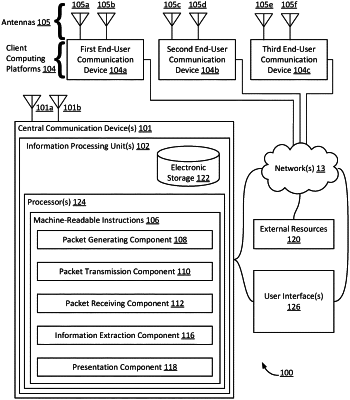| CPC H04W 72/30 (2023.01) [H04N 7/147 (2013.01); H04W 72/044 (2013.01); H04L 12/1881 (2013.01)] | 20 Claims |

|
1. A system configured for facilitating wireless intercom in a local communications network, the system comprising:
one or more hardware processors configured by machine-readable instructions to:
generate, by a central communication device, a first broadcast packet and a second broadcast packet;
transmit the first broadcast packet, via a first transceiver of the central communication device, to a set of end-user communication devices, wherein transmitting the first broadcast packet uses a first channel of a first frequency range, wherein the set of end-user communication devices includes a first end-user communication device and a second end-user communication device;
transmit the second broadcast packet to the set of end-user communication devices, wherein transmitting the second broadcast packet uses a second channel of the first frequency range;
receive a first device-specific packet, on the first channel during a first uplink time period, wherein the first device-specific packet is received from the first end-user communication device, wherein the first device-specific packet includes packetized uplink information based on audio information captured by the first end-user communication device;
receive a second device-specific packet, on the first channel during a second uplink time period, wherein the second device-specific packet is received from the second end-user communication device, wherein the first time period is different from the second time period;
receive the first device-specific packet, on the second channel during a third uplink time period, wherein the first device-specific packet is received from the first end-user communication device, wherein the third uplink time period does not coincide with the first uplink time period, thereby providing time diversity for communications of the first device-specific packet by the first end-user communication device, and wherein the first channel uses a different frequency band than the second channel, thereby providing frequency diversity for communications of the first device-specific packet by the first end-user communication device;
receive the second device-specific packet, on the second channel during a fourth uplink time period, wherein the second device-specific packet is received from the second end-user communication device, wherein the fourth uplink time period does not coincide with the second uplink time period, and wherein the third time period is different from the fourth time period;
generate a third broadcast packet that includes packetized downlink information, wherein the packetized downlink information is based on the audio information of the first device-specific packet, wherein the third broadcast packet includes a destination indication that indicates a network destination in the local communications network for the included packetized downlink information, wherein the network destination includes the second end-user communication device; and
transmit the third broadcast packet to the set of end-user communication devices.
|